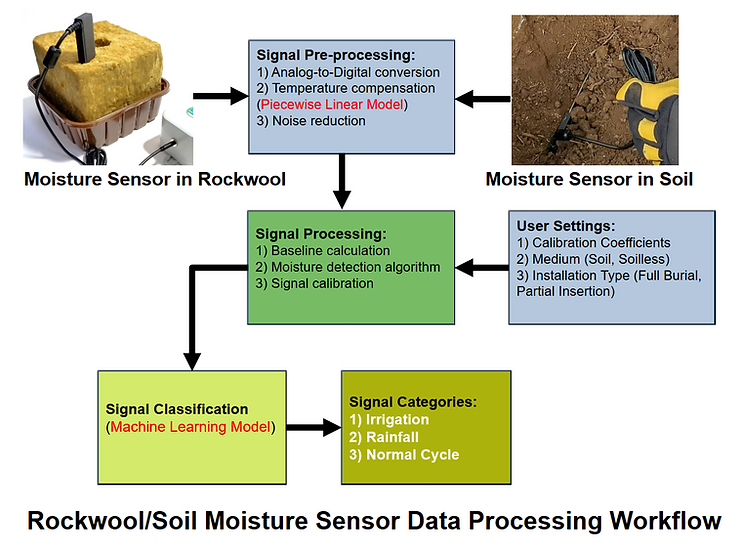Cracking the Code of Sensor Data: Transforming Raw Data into Actionable Insights
I've combined two of my previous posts on sensor data processing pipeline into a single article to help understand and leverage the power of sensor data.
In the article, I provide an overview of the intricacies of leaf wetness and soil moisture sensors, explore the challenges of raw data, and provide a step-by-step approach to data processing and analysis.
Key topics covered:
• 𝗗𝗮𝘁𝗮 𝗣𝗿𝗼𝗰𝗲𝘀𝘀𝗶𝗻𝗴 𝗣𝗶𝗽𝗲𝗹𝗶𝗻𝗲: From raw data to actionable insights
• 𝗧𝗲𝗺𝗽𝗲𝗿𝗮𝘁𝘂𝗿𝗲 𝗖𝗼𝗺𝗽𝗲𝗻𝘀𝗮𝘁𝗶𝗼𝗻: Accurately accounting for temperature variations
• 𝗡𝗼𝗶𝘀𝗲 𝗥𝗲𝗱𝘂𝗰𝘁𝗶𝗼𝗻: Filtering out unwanted noise
• 𝗠𝗮𝗰𝗵𝗶𝗻𝗲 𝗟𝗲𝗮𝗿𝗻𝗶𝗻𝗴 𝗔𝗽𝗽𝗹𝗶𝗰𝗮𝘁𝗶𝗼𝗻𝘀: Classifying sensor data for specific events and conditions
To further explore the specific methodologies and findings discussed in the article, I encourage you to consult the references provided at the end. Feel free to reach out with any questions or comments you may have.
Introduction
In my research, I've delved into the intricacies of leaf wetness and soil moisture sensors. These devices provide valuable data for monitoring agricultural and environmental conditions.
However, raw sensor data can be susceptible to noise and temperature variations, making it challenging to extract accurate insights. To address these challenges, I've developed a comprehensive data processing pipeline that leverages advanced techniques to enhance data quality and enable meaningful analysis.
Challenges in Raw Sensor Data
Raw sensor data, whether from leaf wetness or soil moisture sensors, is often affected by:
Noise: Unwanted signal fluctuations that can obscure true measurements.
Temperature Variations: Changes in temperature can influence sensor readings, particularly for leaf wetness sensors.
Without proper processing, these factors can lead to inaccurate and misleading interpretations of the data.
Data Processing Pipeline
To overcome the limitations of raw sensor data, I've implemented a multi-step data processing pipeline:
Signal Pre-processing
Analog-to-Digital Conversion: Converting continuous analog signals into discrete digital values.
Temperature Compensation: Adjusting sensor readings to account for temperature-induced variations. A piecewise linear model is employed to compensate for non-linear relationships between temperature and sensor output.
Noise Reduction: Filtering out unwanted noise and interference to improve signal quality.
Signal Processing
Baseline Calculation: Establishing a reference point for dry conditions to accurately measure changes in wetness or moisture content.
Feature Extraction: Identifying relevant features like peak amplitude, duration, and frequency to facilitate analysis and classification.
Normalization: Scaling data to a common range for consistent comparison.
Signal Classification
Machine Learning Models: Utilizing machine learning algorithms to categorize sensor signals into specific classes. For leaf wetness sensors, models can classify events like rainfall, dew, and frost. For soil moisture sensors, classification can help identify different moisture levels, trends and events such as rainfall or irrigation.
Case Study: Leaf Wetness Sensor
My research on leaf wetness sensors has yielded significant insights:
Baseline Calculation: Without establishing a well-defined reference point for dry conditions, it is impossible to accurately identify wetness events. To address this challenge, I have developed an efficient algorithm that effectively removes various sources of noise and generates a reliable dry baseline for sensor measurements.
Temperature Compensation: I've developed a piecewise linear model to accurately compensate for temperature-induced variations in sensor readings.
Machine Learning Model: I've trained a machine learning model that effectively classifies leaf wetness events based on features like leaf wetness, sensor temperature, and time.

Case Study: Soil Moisture Sensor
For soil moisture sensors, I've discovered a complex non-linear relationship between soil moisture and temperature. To address this, I've developed a novel piecewise linear regression model that accurately accounts for temperature sensitivity across different moisture ranges. This model significantly improves the accuracy of soil moisture measurements.

Conclusion
By effectively processing and analyzing sensor data, we can unlock valuable insights into plant health, soil moisture dynamics, and environmental conditions. My research highlights the importance of robust data processing techniques in transforming raw sensor data into actionable information.
To delve deeper into the specific methodologies and findings, I encourage readers to explore the references provided below.
References
Osroosh, Y., 2024. Moisture Sensor Data Processing: From Raw Signal to Accurate Measurements and Classification. EnviTronics Lab, November 17.
Osroosh, Y., 2024. Leaf Wetness Sensor Data Processing: From Raw Signal to Accurate Classification. EnviTronics Lab, November 10.
Osroosh, Y., 2021. Why Most Leaf Wetness Sensors Are Unreliable and What a Reliable Sensor Should Look Like? EnviTronics Lab, March 22.
Osroosh, Y., 2020. Why Soil Temperature Fluctuations Result in Inaccurate Soil Moisture Measurements? EnviTronics Lab, March 22.


Comments
Post a Comment